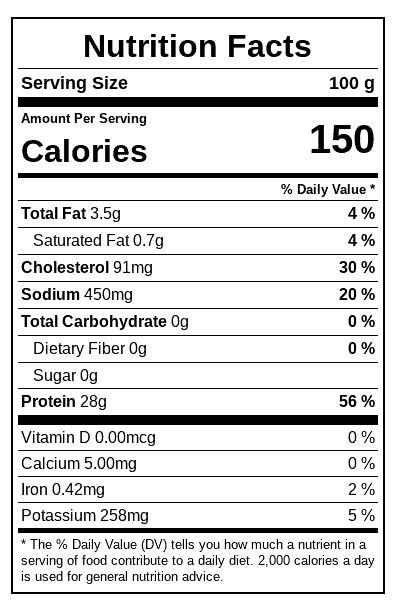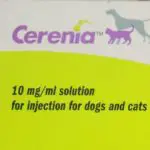Did you know that chicken is the most widely consumed meat in the US? On average, each American ate nearly 50 kg of it in 2017.
It is also perhaps the cheapest.
Two reasons that influence why so many people would want their dog to eat as much chicken as they do.
In this article, I look at how much chicken you should be feeding a dog daily as well as thinking about whether chicken can meet all of your dog’s nutritional needs.
Apart from its cheap price and the fact you love to eat chicken as well, chicken has a reputation for being lean, healthy and also quite bland and easy to digest.
On the surface, it seems like the perfect meat.
But before I look at the nutritional benefits that chicken can bring to a dog bowl, I want to look at the tricky issue of calculating how much chicken you should feed your dog every day.
What you will learn in this article
- How much chicken to feed a dog daily? Two methods
- Why a rough guide should be all you need
- How much cooked chicken should I feed my dog?
- How much chicken breast should I feed my dog?
- Can I feed my dog chicken every day?
- The complete and perfect dog diet
- What nutrition does chicken have?
- Canned and dry foods
How much chicken to feed a dog daily? Two methods
I am presuming in this first section that you want to know how much chicken to feed your dog daily because you want your dog to only eat chicken.
And of course every dog is different because it depends on their size, levels of activity and how good their metabolism is.
Method 1: 3% rule
So the first rule of thumb is this.
For dogs on a raw food diet (and feeding your dog cooked or uncooked chicken is similar to this) feed your dog between 2-3% of their body weight daily.
And so the total we are looking for is in grams- or kilograms if you have a large breed dog.
Some people get confused and expect an answer to be in the form of the number of calories to feed your dog in a day.
So, let’s use my dog Sylvie as an example.
Sylvie is 30 kgs (or just over 66 lbs.)
To work out how much I should feed her, I would divide either 30 kg or 66 lbs by one hundred and multiply that by 2.5.
30 kgs divided by 100 equals 0.3 kg or 300 g.
Which now needs to be multiplied by two, which gives me 0.6 kg or 600 g.
600 g is 2% of her body weight and so I would start off feeding her that for a week or so.
Method 2: online calculator
The second way of working it out is to use an online calculator.
This one looks good– it is a bit basic but it gets the job done.
All you need is to know is your dog’s current weight (in kilograms.)
And if you want your dog to gain, lose or maintain their weight.
And thinking about it, these options are great because you might have already decided that your dog is underweight or overweight and that you want to change the amount of food that you are giving them.
Now that we have worked out how to find the recommended weight of chicken to feed your dog daily, I want to move on and talk about why you should only use this as a starting point.
Why a rough guide should be all you need
No one can tell you the exact amount of chicken that you can feed your dog daily, apart from you.
No matter how clever any calculations that we make, it is unlikely that they will be a perfect match for your dog.
Obviously this is because every dog is different and that in making the calculation, we only took the weight of the dog into account.
Other important factors that affect how much food your dog needs to eat include how active they are and how old they are.
But even if there was a perfect calculator available, I still don’t think it is a good idea.
Being careful to keep an eye on how much we are feeding our dogs and whether they are underweight, overweight or just fine is an important part of being a responsible dog owner.
Why would I want to pass that over to an algorithm?
You can find lots of images online that show you the shapes of underweight and overweight dogs but for me I can find this out just by looking at them or stroking them.
Obviously, I don’t want to see ribs but I do want to be able to easily feel my dog’s ribs under a thin layer of skin.
Fine tuning is very important.
OK. You have a starting weight of the amount of chicken you should feed to your dog daily.
Where do you go next?
So, for instance, if you use the rough estimate with your dog and then over the next few weeks your dog seems to be “underweight”, then start to gradually increase the amount of food that you are giving them.
If the reverse happens and the rough estimate puts weight on your dog, then give them less.
But either way, don’t make sudden changes.
If your dog seems underweight then feed him 20% more chicken everyday for a week and then check again.
If they seem underweight, then feed them 20% less every day for a week and check again.
It is important to not panic and to change the amount that you are giving them on a daily basis.
This is because once your dog gets to an ideal weight, you won’t know what the correct amount to feed them is because you have chopped and changed so often.
And now that we have discussed how much chicken to feed your dog, in the next section few sections I want to discuss the type of chicken to feed your dog.
How much cooked chicken should I feed my dog?
The amount of cooked chicken that you should feed your dog doesn’t change- it is around 3% of their body weight every day.
In this section, I want to explain why feeding your dog cooked chicken is safer for you and your dog than feeding them raw chicken.
And although it is more work for you (because you can’t just take it from the wrapper and put it in your dog’s bowl) cooking it will be safer.
This is because raw chicken contains dangerous bacteria, such as Campylobacter or Salmonella.
And I know that the strong acids in a dog’s stomach make them less likely to suffer a bacterial infection from eating raw chicken, but…
Dogs can become infected with Campylobacter and Salmonella.
And here are the symptoms.
So why take the risk?
The other risk from feeding raw chicken to your dog is that it might make you ill- if you don’t thoroughly wash any surfaces, containers, or utensils that you used in order to kill any potential bacteria.
Whatever you do, just bear those real risks in mind.
Having added to the whole raw vs cooked chicken debate, I now will look at the best part of the chicken to feed your dog…
How much chicken breast should I feed my dog?
Aren’t chicken breasts just so convenient?
Did you know that chicken breasts are the most popular cut of chicken bought in the US?
Nearly 60% of all chicken cuts that are bought in the US, are chicken breasts and the next most popular are chicken thighs at 12%.
Although chicken breasts tend to be the most expensive cut to buy because they are just so convenient, they are also the healthiest part of the chicken.
Chicken thighs tend to have more calories and more fat per serving than the breasts.
As I explain later on though, your dog’s nutritional needs are different to ours.
Another advantage of a chicken breast over a chicken thigh or chicken drumstick is that they come without any bones.
And chicken bones because they are so small, could be a choking hazard for many dogs.
Next up, I want to tackle the thorny issue of whether dogs can survive on chicken alone…
Can I feed my dog chicken every day?
So far in this article, I have discussed only chicken when it comes feeding your dog.
But should dogs only be fed one sort of meat?
The short answer is no, they shouldn’t be fed just one sort of any meat.
And they shouldn’t just be fed meat unless it is from a can of “complete” dog food.
Dogs need a balance of proteins, fats, carbohydrates vitamins and minerals in their diet.
And it’s impossible to absorb everything they need from chicken.
I will look at this more closely in the next section.
The complete and perfect dog diet
Scientists have worked out exactly what dogs need from the food they eat.
A brief outline of what an adult dog needs are:
| Protein | 18% |
| Fats | 5.5% |
| Minerals (includes) | Includes calcium, phosphorus, potassium, sodium, chloride, magnesium, iron, copper, manganese, zinc, iodine, selenium |
| Vitamin(includes) | vitamin A, vitamin D, vitamin E, thiamine, riboflavin, pantothenic acid, niacin, pyridoxine, folic acid, vitamin B12, choline |
And although in my chart the names of the vitamins and minerals are only listed, if you read this document the exact amounts of all of the minerals and vitamins are included.
And all of those things cannot be gained from only eating chicken.
To prove it, in my next section I will look at what nutrition is in a chicken.
What nutrition does chicken have?

On the right we have the nutrition data for chicken.
For ease, this data specifically applies to 100 g of skinless stewed chicken breast.
From the chart above, we know that dogs need food that is about 18% protein.
Chicken breast is 28% protein- which is heading towards twice the required amount .
Its fat content is about 3.5% which is too low as scientists believe that dogs should have around 5.5%.
As far as the minerals and vitamins are concerned, chicken contains most of the minerals or vitamins that a dog needs but as with the protein and fat content, the amounts and concentrations of each is wrong.
For instance, this 100 g piece of chicken breast contains .42 mg of iron or 4.2 mg in every kilogram.
The recommended amount for dogs is 40 mg in every kilogram and so it is too low.
And the problem isn’t just chicken, it applies to all meats as I demonstrate below

Our chart shows a comparison between the science or perfect dog diet against different cooked meats- chicken breast, ground mince, ground lamb and salmon steak.
I have colour coded the chart so that we can see how inappropriate these different meats are in meating essential requirements in a dog’s diet.
A figure written in red is too high.
A figure in purple is too low.
A green figure is there or thereabouts!
And the chart is mostly filled with red and purple figures that show how inappropriate any of these meats would be for meeting your dog’s nutritional needs if they were fed one type of meat.
Canned and dry foods
Most sorts of wet or canned dog food and dry kibble are known as complete diets.
This means that a dog can survive and thrive on one type of canned food or another and one type of kibble or another.
These foods have all been specially created to provide everything that a dog needs in every respect- from the right amount of protein, fat to the precise amounts of vitamins and minerals as laid out by the scientists at AFFCO.
To be clear, I’m not saying that these cans of dog food or these bags of kibble are all perfect- I would think many of them are far from perfect.
But what legally they have to provide is a correctly balanced diet specifically designed for dogs.






